10 October 2022 Modified: 03 September 2024
LEDs – the icon of modern lighting
The first LEDs were developed in the 1960s. Since then, they have gradually gained popularity, so that today they are practically an icon of modern lighting. LEDs can be found almost everywhere. In shops, offices and also in our homes. One of the biggest advantages of LEDs is that they come in countless colour variations, shapes and sizes. As a result, they offer enormous freedom and choice when it comes to the lighting design of a space.
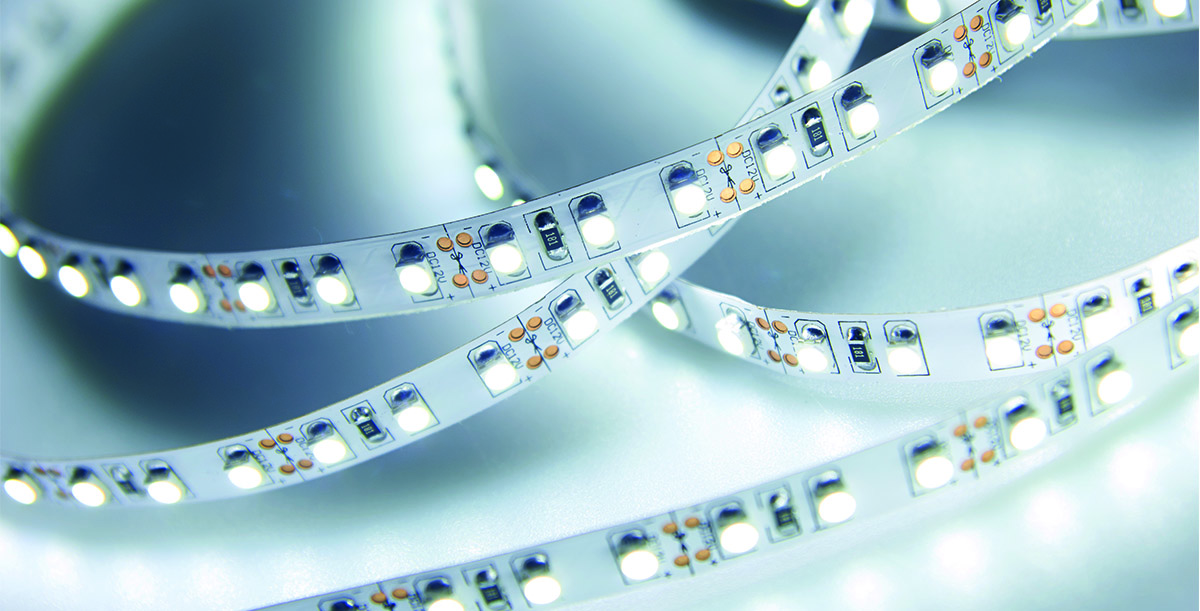
What is an LED and what types are there?
A electroluminescent diode, also known as an LED (Light Emitting Diode), is a semiconductor element that emits light as a result of the current flowing through it. Depending on the type of semiconductor used, the diode generates light of different colour and wavelength. Therefore, we distinguish between warm, cold and neutral light LEDs, single-colour (RGB) and multicolour (RGB) LEDs, as well as ultraviolet (UV) and infrared (IR) LEDs.
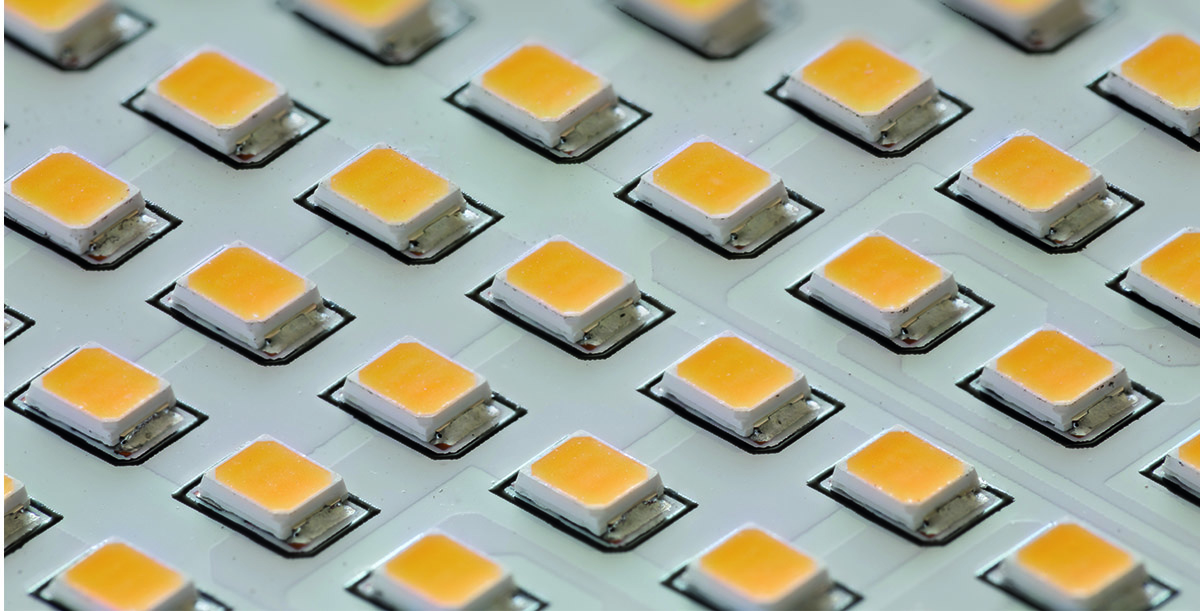
Multifunctional LEDs
The specific design of LEDs is what makes them so popular. Not only in homes or flats, but also in electronics. They can be found in the form of an bulb, an LED strip, as well as divided into individual components. They are very often used in various types of electronic equipment, such as mobile phones (flashing LED, informing of a new message), computer keyboards (illumination of the CapsLock key) or modern PC cases. It is worth mentioning that LED technology is increasingly replacing the old solutions, which consume a lot of energy and are therefore expensive. Today, almost all light bulbs available on the market are manufactured based on LEDs. Thanks to the countless colour possibilities, LEDs are used in everyday life. They are perfect for illuminating kitchen cabinets or as lighting strips mounted near the ceiling. LEDs subtly help to emphasise the character of a space, create a cosy atmosphere and add originality to PC enclosures with coloured fans.

7 advantages of LED lighting
There is a reason why LED lighting is so popular. We are increasingly switching from traditional incandescent or halogen lighting to LED lighting. This is due to a number of advantages that leds offer. Learn about the most important ones.
- Energy efficiency
Lighting with LEDs is the ideal solution for anyone who not only wants to keep up with technological innovations, but also wants to take care of the household budget. LED light sources use 70 to 90 % less electricity than conventional lighting technologies. As a result, by illuminating even small rooms, we are able to notice the difference in bill payments. What's more, by using LEDs, we are also taking care of the environment.
- Exceptional lifetime
LED lighting is characterised by long life and durability. The average LED bulb is capable of operating between 30,000 and 50,000 hours without failure. In comparison, a traditional tungsten bulb lasts an average of 1,000 hours - a huge difference. What is more, leds are highly resistant to shocks, mechanical damage, switching on and off and even voltage fluctuations. We therefore gain doubly. Not only do we save on reduced power consumption, but we also reduce the frequency with which we have to replace the bulbs with new ones, thereby reducing the amount of generated rubbish. In practice, this can even mean not having to change bulbs at all in areas where they are rarely lit.
- Less heat up
Traditional incandescent bulbs heat up quickly as soon as they are switched on. Therefore, care must be taken to ensure that they do not accidentally come into contact with heat-sensitive materials, as they can over-melt them and even cause a fire. In this respect, LED lighting is clearly superior to classic incandescent lamps. It is incomparably safer, precisely because of its low thermal emissions. It is much more difficult to burn with it, as well as to damage the delicate lamp frame or decorative lampshade.
- Environmental protection
LED lighting is ideal for anyone who operates with an environmentally friendly approach to life in mind. No dangerous heavy metals such as mercury, which is used in fluorescent lamps, are used in the production of LEDs. Therefore, LED technology is very attractive from an environmental point of view. Not only does it consume significantly less energy and last longer, it is also safe for health and the environment.
- Safety and smooth operation
LED bulbs are not only safe due to their low heat emission. Compared to fluorescent lamps, LED light sources are flicker-free. This ensures that the light emitted does not tire the eyes and is therefore neutral to our eyes.
- Any colour
LEDs can emit light of almost any colour temperature and colour. For the user, this means that we can choose the type of light according to our own tastes or current needs. The options are numerous. We can choose a warm colour, which is ideal for rooms such as the living room or bedroom. It will accentuate the decorations in the room and create a pleasant and welcoming atmosphere. Or we can opt for the universal solution of a neutral light colour. This is an excellent choice for rooms that are transitional or that have multiple functions. A cold colour, on the other hand, is great for workstation lighting. What is more, some LEDs can be connected to a controller, allowing us to change the colour and intensity of the light without getting up from the sofa.
- Small size
LEDs are characterised by their small size, so there are endless design possibilities with them. We can find them both in single configurations as signal and measurement LEDs, as well as connected in groups to form displays or LED bulbs.
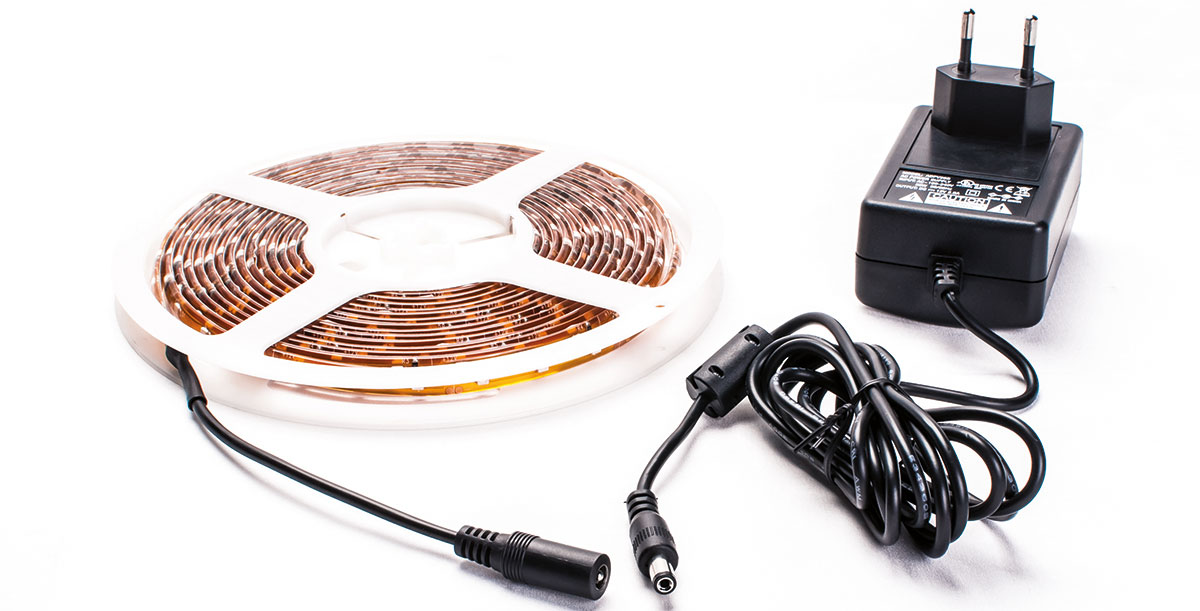
Who is LED lighting for?
Since LED technology has come into widespread use, the design possibilities for interior lighting have increased significantly. Thanks to these small LEDs, we can adapt the style and character of a space to our individual needs, our current mood or the aura outside. LED lighting will work in any room, regardless of its purpose. It is also worth noting that the use of LEDs will allow us to transform and modernise our chosen space in a short period of time and at a low cost. What is more, appropriately planned and installed LED lighting will fit perfectly into both Scandinavian, rustic and loft style rooms. The versatility of LED technology will also be appreciated by the owners of cafés, pubs or discos. The multitude of colours, the ability to select the intensity of colour and brightness means that everyone will find a solution perfectly matching their concept and assumptions.

How do I choose LED strips?
Lighting a staircase, kitchen worktop or gazebo? LED strips can be used anywhere, whether indoors or even in the garden. Depending on what interior we want to illuminate, we need to pay attention to the basic parameters of the strip provided by the manufacturer. Important parameters are such as:
- resistance class,
- the length of the strip,
- number and type of LEDs,
- the power of the light generated,
- colour temperature,
- light colour,
- supply voltage,
- power consumption.
Resistance class
Resistance class is a parameter that tells us in which conditions we can install the selected LEDs. The most common models are rated IP20, IP44 and IP68. The IP20 symbol indicates that the strip does not have any protection against water, so this type of strip can only be used in dry areas. They are not resistant to the elements and are therefore not suitable as bath or garden shed lighting. The next protection class IP44 already allows the strip to be placed in slightly more humid areas, such as the bathroom or kitchen. Class IP68, on the other hand, is a higher protection class, which allows the installation of lighting, among other things, outdoors, where the tape will be exposed to significant temperature differences and precipitation.

Colour temperature
When deciding to use led strips to illuminate a selected room, it is important to remember both to calculate the length of strip needed and to select the colour of the leds. You should consider whether you need warm, cold or perhaps natural light.
Not sure when we call light cold and when we call it warm? That's what the aforementioned colour temperature is responsible for, which is expressed in Kelvin [K] and is as follows:
- Cold colour – from 4600 [K]
- Neutral colour – 3500-4500 [K]
- Warm colour – up to 3500 [K].
The choice of colour temperature is primarily a matter of personal preference. However, it is advisable to consult specialists. Interior designers agree that warm colours are best in rooms intended for relaxation. In a study or office, on the other hand, cold-coloured LEDs are preferable. A cooler shade of light helps to maintain concentration and therefore allows us to better focus on our work and our tasks.
Light output
In addition to the colour temperature, we can also choose the power with which the strips will shine. This power is called lumen output and is expressed in lumens [lm]. It depends on the type of LEDs used and their number. The LEDs are easily distinguished by special markings. Those marked with the number 5630 or 5730 are currently the most powerful LEDs available on the market made using SMD technology. These LEDs are capable of emitting a luminous flux of up to 55 lm. In comparison, the popular SMD 2835 model used for decorative lighting generates only 5.4 lm. This is almost 10 times less than the 5630 model. What is more, the total power emitted by the strip is also determined by the number of LEDs per metre of strip length. The more LEDs, the brighter the strip will shine.
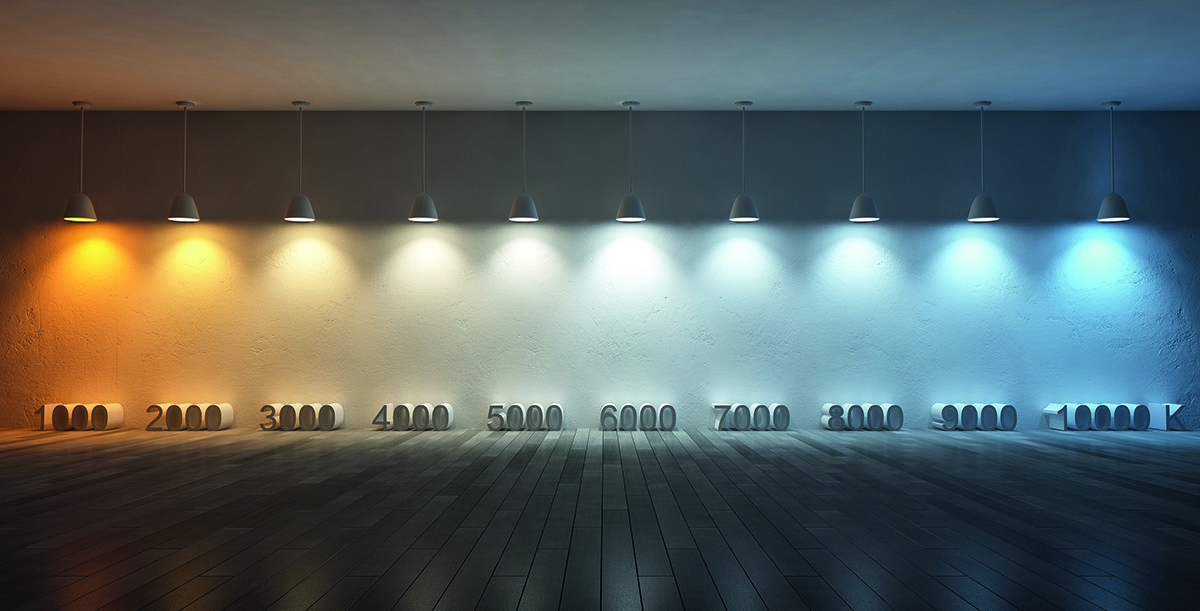
Light colour
LEDs not only emit light of different colour and power, but also colour. The more advanced RGB LEDs allow the colour of the emitted light to be changed to any colour through the controllers. They are used in all kinds of Christmas decorations as well as RGB fans.
Supply voltage and power consumption
LED strips are not connected directly to the mains power supply in comparison with traditional incandescent or led light bulbs. This is because led strips are powered by 12 or 24 volts. Due to the fact that both the size and complexity of lighting installations and the power of the selected LEDs vary, the power source must be selected individually. Manufacturers provide parameters such as supply voltage and power consumed by a metre of LED strip to make it easier. On this basis, we are able to calculate which power supply should be used for a particular installation.
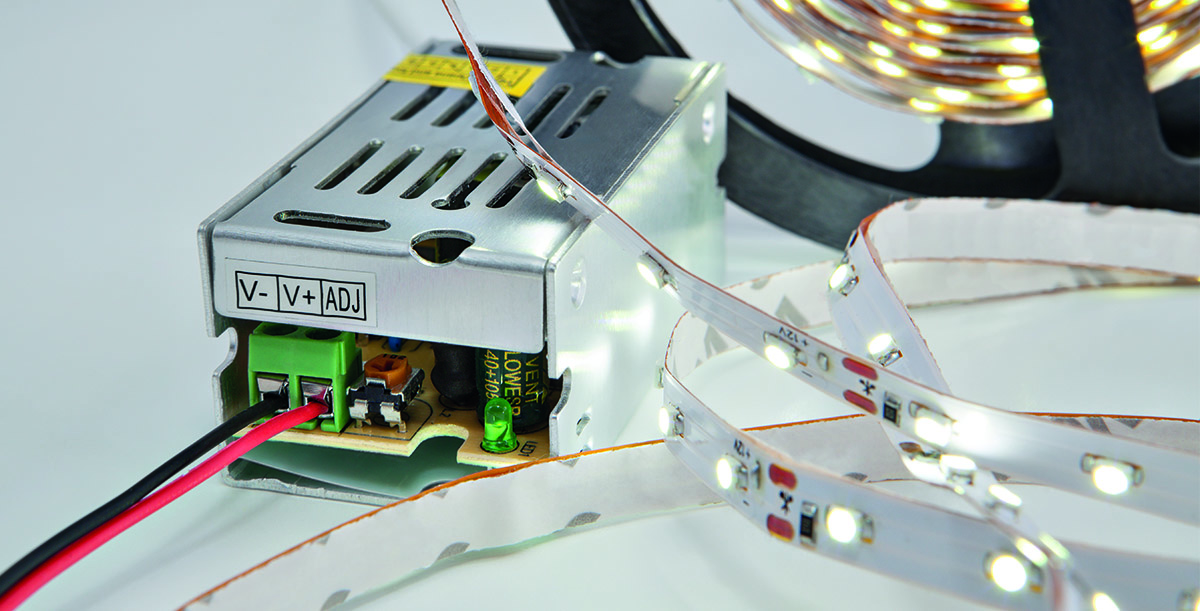
How to choose a power supply for LED strip?
Choosing the right LED power supply should be the first step when installing lighting. The most important parameters to pay attention to before choosing it are the supply voltage, the power consumed per metre of strip and the length of the LED ribbon. The supply voltage and power are given by the LED strip manufacturers, while the length is an individual value for each installation. The minimum wattage of the power supply is calculated by multiplying the length of the strip expressed in metres by the wattage of the strip, and then selecting a power reserve of min. 10% to guarantee long and trouble-free operation of the system, unless the LED strip manufacturer recommends otherwise. The formula for the power supply power is as follows:
(Length of LED strip [m] x power consumed by metre of strip [W/m]) x 110% = min. power supply wattage [W].
Once we have calculated the minimum power supply wattage, we need to decide whether we need an hermetic LED power supply or whether a standard modular LED power supply will suffice. If the installation is to be done outdoors or in the bathroom, we choose a power supply with a higher resistance to moisture. On the other hand, if the installation is to be carried out indoors in dry rooms, a modular power supply is sufficient. In the event that our LED strip has a quick connector with a DC socket, it is advisable to use a plug-in power supply.
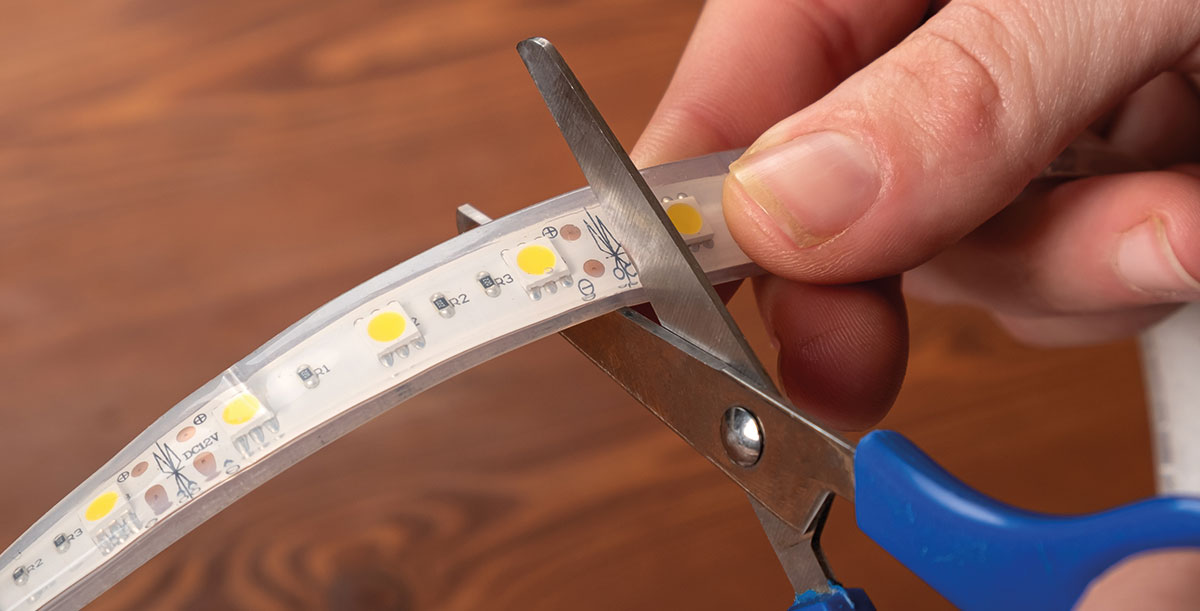
Can an LED power supply be too powerful? What if my power supply is too powerful?
When it comes to LED power supplies, the term 'too powerful' is often misunderstood. The power supply delivers a specific voltage and maximum power, while the LED strip itself only draws as much energy as it actually needs. This means that if you choose a power supply with more power than the minimum required, this will not damage the LED strip. On the contrary, the power supply's spare power is advisable, as it reduces the load on the power supply and extends the life of the whole system. On the other hand, a power supply with too high a voltage would be a problem - this could lead to LEDs burning out. Therefore, always choose a power supply that is compatible in terms of voltage with the LED strip, e.g. a 12 V strip requires a 12 V power supply.
Does the larger power supply draw more current?
This is a common question, stemming from concerns about energy bills. A larger power supply does not automatically draw more power - the power consumption depends on how much power the connected LED strip draws. If we connect a strip with a power requirement of 50 W to a 200 W power supply, the power consumption will be around 50 W (and a small power supply loss). The power supply's wattage only determines its maximum output, not its constant energy consumption. Therefore, a larger power supply will not adversely affect your bills as long as it works in conjunction with the right LED lighting.
How to connect an LED power supply correctly?
If the length of the LED strip exceeds 5 metres, the problem of voltage drop begins to appear. You will notice a loss of LED light output as the distance of successive modules from the power supply terminals increases. In this case, a parallel connection is recommended. It consists of dividing a long LED strip into equal sections, preferably not exceeding 5 m. For example, a 10 m strip should be divided into two sections of 5 m each. To do this, cut the strip at the designated point - usually marked with the scissors icon. The two separate LED strips are then connected to the LED power supply. Examples of how to connect the LED strip to the power supply are shown in the figure below.
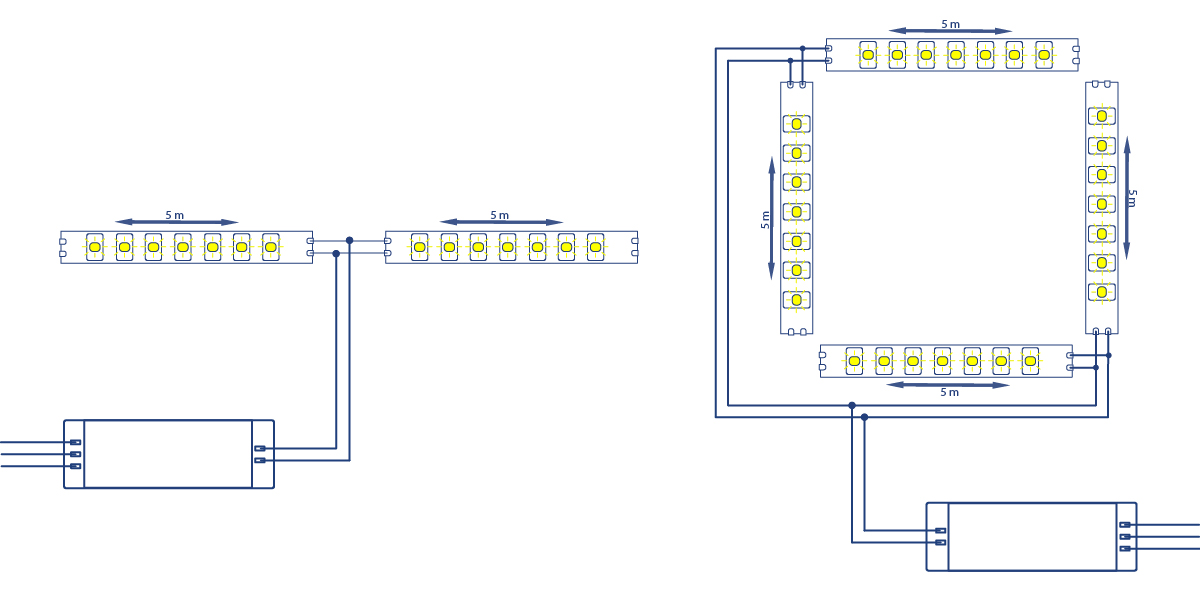
Lighting with LED technology, has an extremely large number of advantages. It allows for any arrangement of a given room, is energy-efficient and environmentally friendly. In addition, installing led strips on your own is not too complicated. This is why leds are so willingly used both at home and in public places. The multitude of applications means that there is something for everyone! See for yourself!
